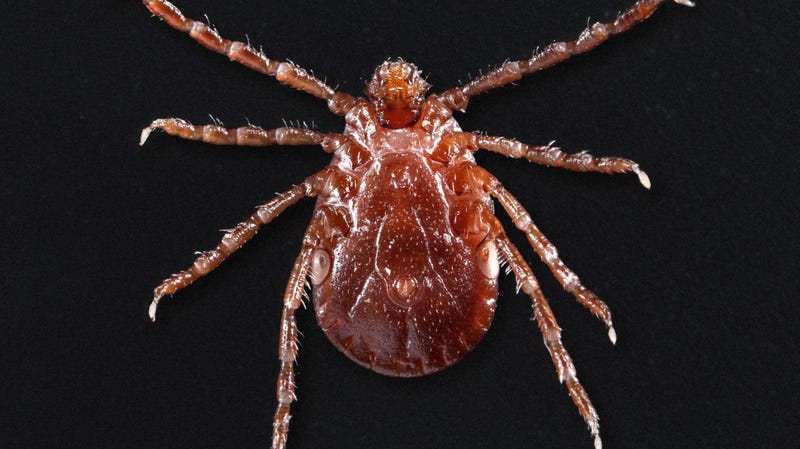Comment; A new tick species invading North America that hosts a new virus–Severe fever with thrombocytopenia syndrome (SFTS).
Ed Cara12/13/18 4:10pmFiled to: TICKS115.8K772

A disease-carrying, newly invasive tick to the United States, the Asian longhorned tick, is poised to spread across much of North America, suggests a new study published Thursday in the Journal of Medical Entomology. According to the study, the tick might be able to live anywhere from Southeastern Canada to most of the eastern half of the U.S. and even parts of the West Coast.
The Asian longhorned tick, or Haemaphysalis longicornis, made an unwelcome splash last year, when researchers and health officials discovered it on a pet sheep in New Jersey. Any hopes that the discovery was an isolated incident faded away this year, with sightings of the tick popping up again in New Jersey and eight other states this past spring and summer (Arkansas, Connecticut, Maryland, New York, North Carolina, Pennsylvania, Virginia, and West Virginia). Since 2017, the tick has been found on pets, farm animals, and at least two people in the U.S., and it’s possible that it might have made its way here at least as early as 2010.
There’s a few things that are really worrying about this tick. It can make more of itself incredibly easily, since female ticks can either mate with males or just asexually reproduce (In the U.S. so far, all longhorned ticks seem to be female clones). These bloodsucking female ticks can also devastate the animals and livestock they feed on, with large-enough infestations capable of severely weakening or even killing their hosts. And at least in some areas where the tick has set up shop, it’s able to carry and spread dangerous diseases to its human victims.
As of yet, the longhorned tick is not believed to have made any person in the U.S. sick, nor have any disease-causing germs been found in U.S. populations. But public health officials at the Centers for Disease Control and Prevention have called the tick “a new and emerging disease threat” that needs to be carefully studied and further surveilled. In the spirit of that urgency, study author Ilia Rochlin, an entomologist and researcher affiliated with the Rutgers University Center for Vector Biology, decided to create a model of the tick’s potential habitable range in North America.
Rochlin’s model relies on existing data from countries where the tick has firmly established itself. As the name implies, the tick is native to Central and Eastern Asia, but it has also invaded Australia, New Zealand, and other Pacific islands. He cross-referenced that data with climate and landscape data from the U.S. The longhorned tick tends to prefer temperate weather, modest humidity, and lots of leafy shrubs and trees, but unfortunately for us, it’s able to adapt to a wide range of temperatures, precipitation, and vegetation.
In the most likely scenario, Rochlin predicted the tick will love living along the coasts, from Canada’s New Brunswick and Nova Scotia to Virginia and North Carolina on the East Coast, and from the southern half of Canada’s British Columbia to northern coastal California. But odds are good that the tick’s range will extend as far as Illinois and Missouri in the Midwest, and possibly even as far south as the drier, northern half of Florida.
“The climatic conditions and vegetation cover are similar to those found in its native range in China, Korea, and Japan,” Rochlin told Gizmodo via email. “The Asian longhorned tick appears to thrive under moderate temperate conditions, but doesn’t do well in dry open country or in tropical rain forest.”
Midwestern and southeastern states might especially have something to fear from the longhorned tick, Rochlin added. These areas bear a close resemblance to mountainous regions of China, where the tick spreads a virus behind an emerging and often fatal disease known as severe fever with thrombocytopenia syndrome (SFTS). The SFTS virus might not have hitched a ride to the U.S. with the tick, but it turns out there’s already a tickborne disease, caused by the closely related Heartland virus and spread by the Lone Star tick, that can be found in the same region.
“Introduction of a tick species that is a competent vector for a closely related virus should be a matter of concern for the public health agencies and requires further investigations,” Rochlin wrote.
Of course, this is only the latest bit of bad tick news. Just this past month, the CDC confirmed a record number of confirmed tickborne disease cases in 2017, continuing a steady trend seen since at least 2004 (the real number of cases is likely tenfold higher, according to the CDC). And as the climate continues to change and more of the U.S. becomes suitable for various species of ticks and insects, it’s almost certain our encounters with some kinds of dangerous bugs will only become more common here (On a worldwide scale, climate change might have a less predictable, maybe even beneficial, effect on the range of some vectors and the diseases they spread).Recent Videos from GizmodoVIEW MORE >
As for the longhorned tick, Rochlin says it’s still up in the air as to how climate change trends would affect its distribution, since it’s already relatively adaptable. That’s one of many questions that future research will have to figure out.
“We need to learn more about this tick species’ biology, ecology, and local distribution. Eventually, when more data are available, localized fine scale habitat modeling on a county or township level can delineate high risk areas providing guidance for surveillance and control efforts,” he said. “We also need to expand the public outreach and education especially to the most exposed—farmers, hunters, outdoor workers, pet owners.”
[Journal of Medical Entomology]
- COVID UPDATE: What is the truth? - 2022-11-08
- Pathologist Speaks Out About COVID Jab Effects - 2022-07-04
- A Massive Spike in Disability is Most Likely Due to a Wave of Vaccine Injuries - 2022-06-30

